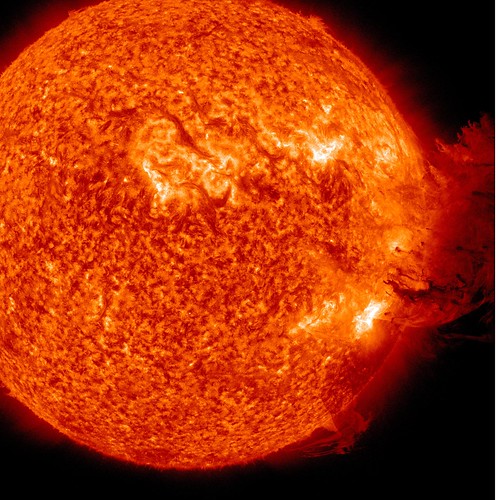
August 28, 1859, is an historic and foreboding date most travelers don’t know.
Of that date, Scientific American reported,
“From Maine to the tip of Florida, vivid curtains of light took the skies. Startled Cubans saw the auroras directly overhead; ships’ logs near the equator described crimson lights reaching halfway to the zenith. Many people thought their cities had caught fire. Scientific instruments around the world, patiently recording minute changes in Earth’s magnetism, suddenly shot off scale, and spurious electric currents surged into the world’s telegraph systems. In Baltimore telegraph operators labored from 8 p.m. until 10 a.m. the next day to transmit a mere 400-word press report.”
That’s a description of the effects of the 1859 solar superstorm.
Intense solar activity runs in approximately 11 year cycles, and the current cycle will peak this year and next.
With today’s dependence on electronics and electric power, peak solar activity, like that in 1859, could cause widespread disruption to aircraft, ship, and automobile navigation, emergency location systems which rely on satellite navigation data, and both wired and wireless communication.
This past February 14, an “X-class” solar flare eruption, the biggest solar flare in four years, disrupted radio communication in China. China’s Meteorological Administration reported the eruption jammed short-wave radio communications in the southern part of the country.
In 2005, Alessandro Cerruti, a grad student working for Dr. Paul Kintner Jr., head of Cornell University’s GPS Laboratory, was operating one of Cornell’s scintillation monitor receivers at the Arecibo Observatory in Puerto Rico. Cerruti was investigating irregularities in the plasma of the Earth’s ionosphere when a major solar flare occurred, causing the receiver’s signal to drop significantly.
Cerruti worked to confirm his discovery, that the world’s satellite based GPS navigation system was vulnerable to intense solar activity. He confirmed his results from receivers’ data from all over the world, which like Arecibo, was sunlit at the time.
For an airplane or ship’s GPS navigation receiver, a significant drop in the satellite signal means the system would have difficulty obtaining the position of the plane or ship, if it could fix the position at all.
Dr. Kintner put it this way,
“If you’re driving to the beach using your car’s navigation system, you’ll be OK. If you’re on a commercial airplane in zero visibility weather, maybe not.”
These problems certainly give one pause as the FAA moves toward their NextGen, satellite GPS based navigation system, along with other countries adopting similar systems. Fortunately, now that this effect is well known, the FAA and other countries’ aviation authorities can be prepared for the inevitable disruptions of NextGen, in the future.
Two possible solutions for NextGen would be to either equip receivers with weak signal-tracking algorithms, so they can continue to read the signals, or to increase the signal power from the satellites.
Additionally, detailed preparation and alternative navigation solutions would seem to be the order of the day for times when severe solar activity occurs.
There is another concern for everyone, including travelers, from the potential effects of intense solar activity.
As reported by the National Geographic Society, during times of intense solar activity, coronal mass ejections (CMEs), cloud-like bundles of plasma that shoot off the sun’s upper atmosphere, or corona, can occur, causing geomagnetic storms on Earth. These storms, which are low probability episodes, could knock out communications, scramble GPS signals, and leave thousands without power for some time.
They could strand travelers causing severe problems for millions.
Rich Lordan, of the Electric Power Research Institute (ERPI) says, “The concern is if the electric grid lost a number of transformers during a single storm, replacing them would be difficult and time-consuming.”
These are not “sky is falling” concerns. In 1989, for example, Canada’s Hydro Quebec power grid collapsed during a solar storm. Millions were without power for nine hours or more.
In both North America and Europe, governments are already at work planning for possible severe problems from intense solar activity. NASA, in cooperation with the EPRI, in 2007, created the Solar Shield Project (SSP). It’s a forecast and reporting system created to mitigate the impact of geomagnetic storms. The forecasting is still termed “experimental” because NASA’s Goddard Space Flight Center is continuing to develop its forecast models.
Under SSP, NASA will provide detailed forecast information to ERPI who will disseminate it across North America, so utilities can take necessary action to preserve their systems, and recover from outages as quickly as possible.
In Europe, their system, called Spacecast, should be in operation by early 2012.
While travelers shouldn’t be overly concerned, at this time, they should take a few commonsense precautions, which may seem simplistic, but I think are worthwhile.
Always travel with a flashlight and spare batteries. You never know when there may be a power outage. If communications are working, but power is out, try to make sure your cell phone was already charged and have an axillary power supply like a Mophie Juice Pack Boost for extended power outages. Take a portable radio with you to get emergency news.
If you’re on a driving trip, like many you might be depending on a GPS to get around. While we’re in the peak years of solar activity, I’d also take those old fashion maps we all used to use in “ancient times.”
After many years working in corporate America as a chemical engineer, executive and eventually CFO of a multinational manufacturer, Ned founded a tech consulting company and later restarted NSL Photography, his photography business. Before entering the corporate world, Ned worked as a Public Health Engineer for the Philadelphia Department of Public Health. As a well known corporate, travel and wildlife photographer, Ned travels the world writing about travel and photography, as well as running photography workshops, seminars and photowalks. Visit Ned’s Photography Blog and Galleries.

